by Todd Rutherford
A visit to the Denver Botanic Gardens has revealed that the first signs of spring are making their presence known. As we have been experiencing a recent warm spell here in the Denver area, I decided to check out the Gardens to see what might be blooming. Sure enough, there were many bulbs and some shrubs that were taking advantage of the balmy weather to burst forth in bloom.
Below are just a small sampling of what’s flowering now at the Gardens:
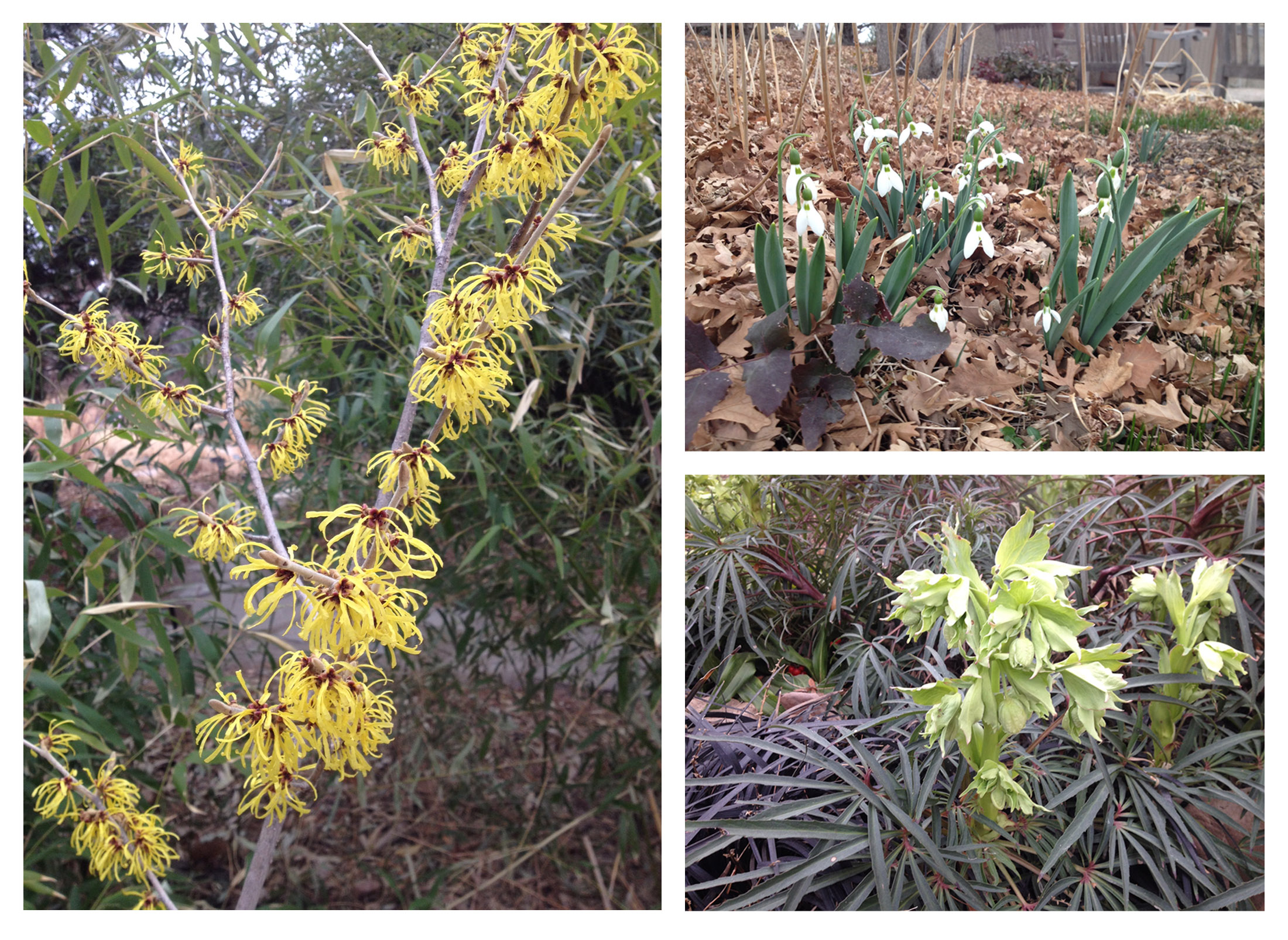
Clockwise from left: Witchhazel; Snowdrops; Hellebores
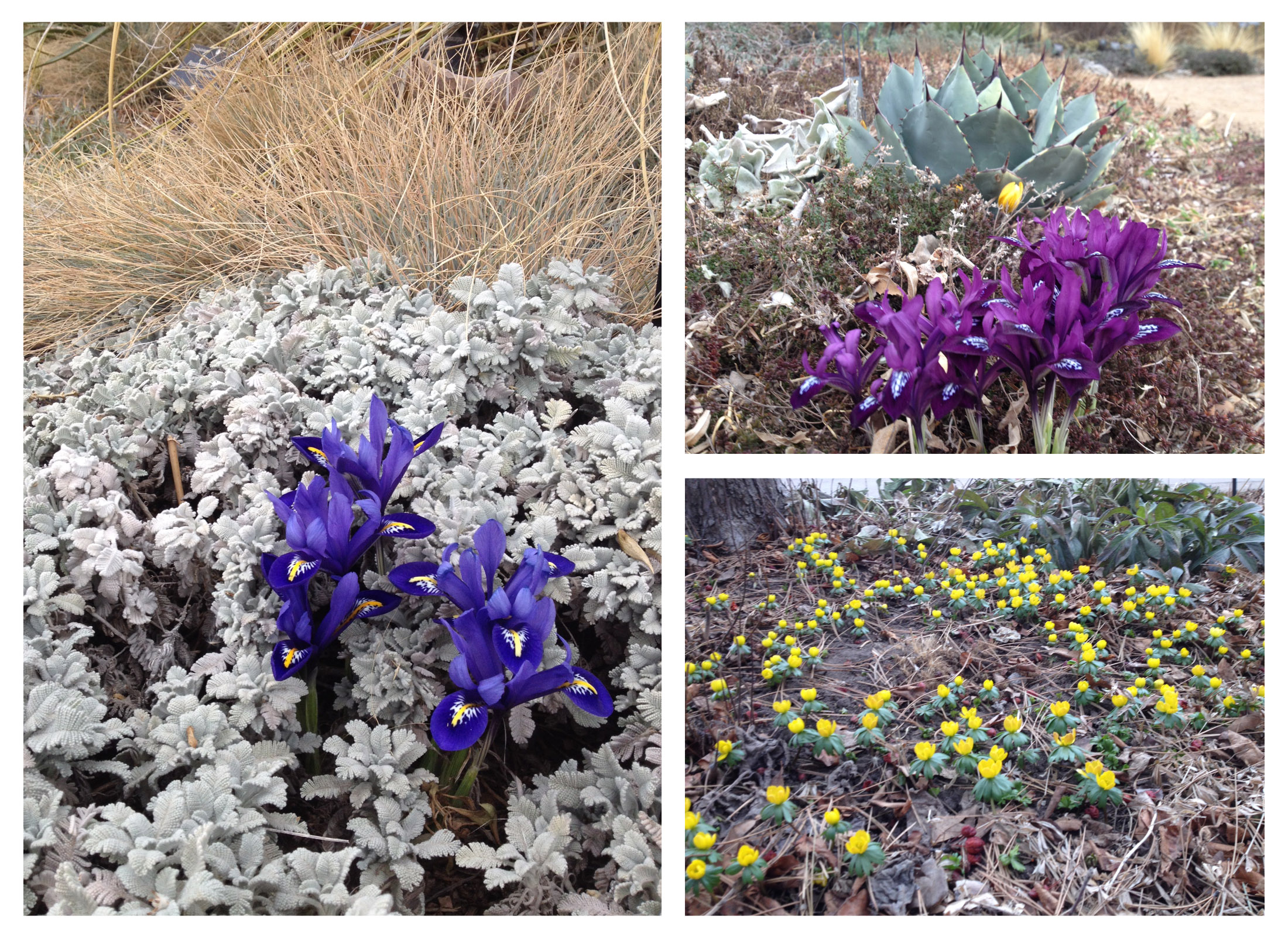
Clockwise from left: Dwarf Iris in Partridge Feather; Dwarf Iris with Crocus and Agave; Winter Aconite
This is the official blog of Outdoor Design Group, Colorado Landscape Architects. For more information about our business and our services, click here.
Related Posts:
by Todd Rutherford
When it comes to trees in designed landscapes in Colorado, landscape architects and designers don’t have very many species to choose from. With that being said, it might seem heretical to propose that the list of trees to pick from be restricted even further. Specifically, I advocate that large evergreen trees NOT be planted in dense urban areas that experience cold winters, unless they are sufficiently distant from walks and streets located north of such evergreens.
The shadows that large evergreen trees cast can help foster ice patches on walks and roads, compromising the safety and welfare of those who utilize these areas to travel about our towns and cities. If we are going to encourage biking and walking to ease automobile congestion and alleviate environmental impacts, having the safest travel routes we can achieve is a noble goal.
It may be surprising to those who don’t work in the landscape, architecture or planning fields, but many municipalities require that a certain number or percentage of the trees on a landscape plan be evergreen trees. Sometimes these arbitrary requirements restrict designers and architects to squeeze these large winter-shading ice patch-makers into a site where it might be best to avoid them. However, I should mention that some municipalities that I’ve worked with do acknowledge the problem of winter shading from evergreen trees, and they do have instructions in their landscape codes to locate proposed large evergreens away from walks and roads that would be shaded by those evergreens.
I first became aware of the problem of evergreen shadow ice patches as an urban bike commuter in the Denver area. It is frustrating at best, and rather dangerous at worst to encounter a patch of ice on a street during winter time. I have found that often times when biking in the Denver area in winter, the majority of streets can be clear of ice, except for those areas shaded by evergreens that are located just south of walks and streets. But it is not just bikers that would benefit from restricting evergreen trees in urban areas. Walkers and runners would also have an improved level of travel safety due to less icing of their pathways.
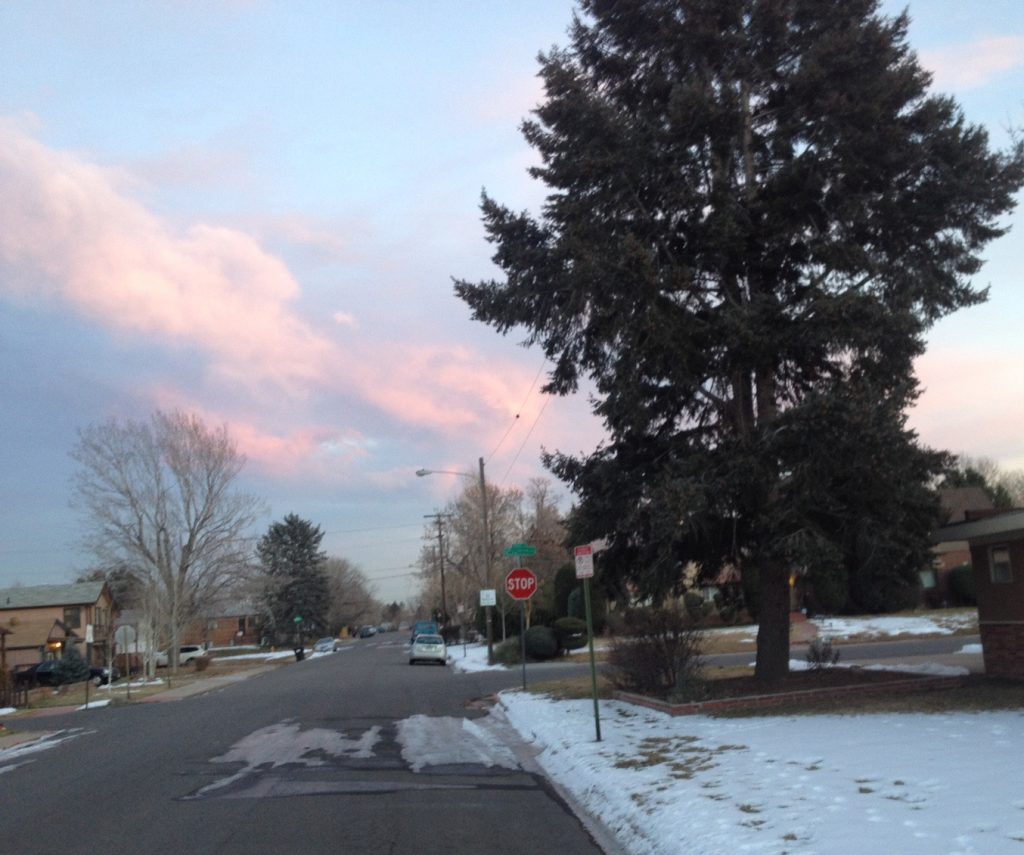
An ice patch on a Denver street, from the shadow of a large evergreen tree.
Because the foliage canopy of pine, spruce and fir trees does not drop during winter, melting of snow and ice via solar gain is limited. Deciduous trees, which drop their leaves and allow more sunlight to reach walks and streets, are a better choice in place of evergreens. I acknowledge that evergreen trees are often used for landscape screening. But I question whether this screening is worth it when considering their impact to roads and walks during winter.
Another impact from lost solar gain due to evergreen tree shading is on homes and other buildings. A building that sits in the winter shadow of a large evergreen tree will miss out on solar warmth during a sunny Colorado winter day.
I do realize that in dense urban areas, it’s not just trees that can shade our streets and sidewalks. People need shelter and workspaces, and some of those structures could end up shading streets and cause ice patches. But residents don’t need evergreen trees on their urban lot. I advocate for trees to create shade in summer, visual interest in all seasons, and wildlife habitat. But the choice of tree in tight urban quarters needs to be considered carefully.
Despite the tongue in cheek title of this blog post, evergreen trees can be a wonderful addition to the landscape. I am not actually asking for evergreen trees to be banned from urban areas of Colorado. However it does seem best that in dense urban areas that experience cold winter weather, we should consider restricting evergreen trees to parks and large lots, away from streets and sidewalks where their winter shade will not cause icy travel dangers for walkers, bikers and even cars.
This is the official blog of Outdoor Design Group, Colorado Landscape Architects. For more information about our business and our services, click here.
Related Posts:
by Todd Rutherford
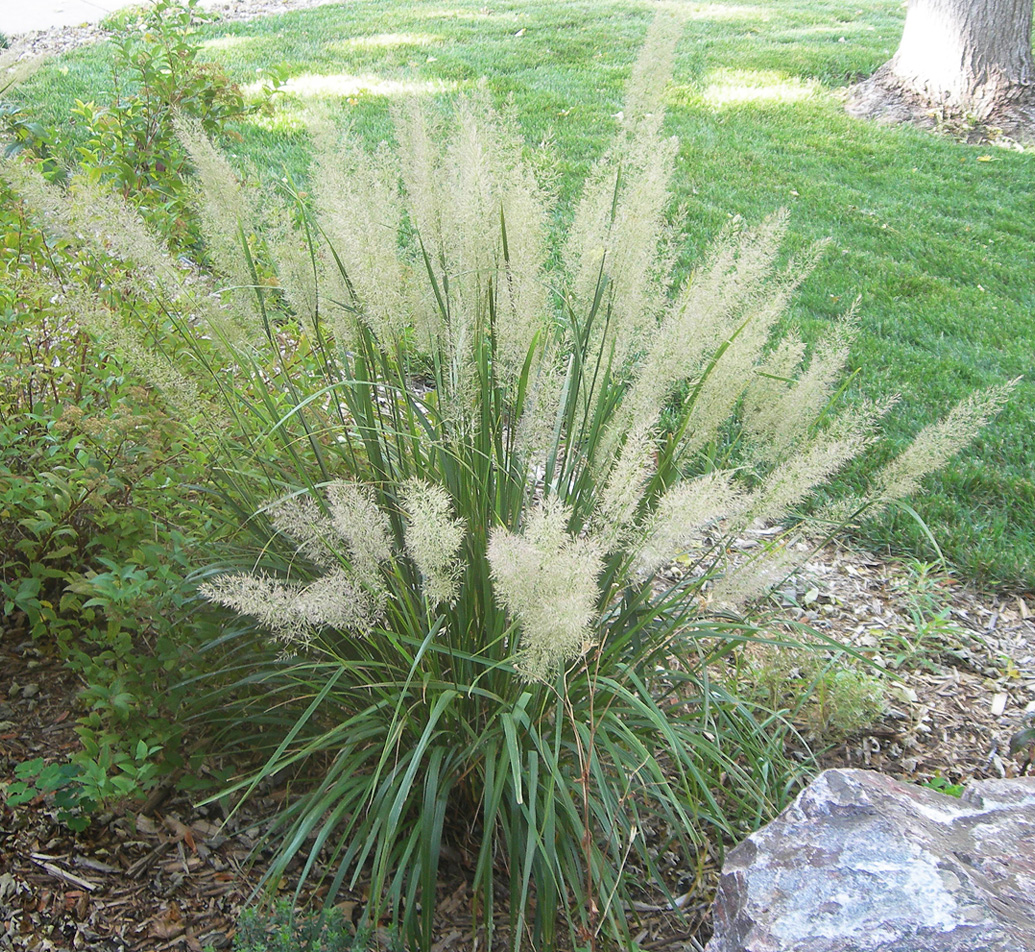
Calamagrostis brachytricha, Korean Feather Reed Grass
Calamagrostis brachytricha, aka Korean Feather Reed Grass, is a clump-forming ornamental grass with green leaves and fluffy flower plumes. It is not as well known as its infamous cousin Calmagrostis acutiflora ‘Karl Foerster’, commonly known as Karl Foerster Feather Reed Grass. But Korean Feather Reed Grass really should get more attention, as it is an indispensable option to add wispy texture to planting schemes in part shade conditions.
PLANT STATS
Scientific Name: Calamagrostis brachytricha
Common Name: Korean Feather Reed Grass
Plant Type: Ornamental Grass
Mature Height: 3-4’
Mature Spread: 2-3’
Cold Hardiness Zone: USDA zones 4 – 9 (up to 6,500 ft)
Water Requirement: Medium. Slightly drought tolerant once established, but prefers adequate moisture. Requires regular amounts of water if it is planted in more sun.
Exposure: Part Sun/Shade
Soil: Tolerant of a wide range of soils.
Flower Color & Bloom Time: The feather like flower spikes have a pink tinge when they initially emerge in late summer, and then fade to straw yellow in fall. Compared to Karl Foerster grass, the flowers of Korean Feather seem to be much more misty and gauzy when they first appear which gives the plants a wonderfully diaphanous appearance.
Winter Interest: Gold foliage and flowers.
Disadvantages: May reseed under certain conditions.
Availability and Sizes: This plant seems to be regularly available at retail nurseries around the front range. It is typically sold in 1 gallon or 4″ pots.
Best Features: A large, showy, flowering ornamental grass that can take shady conditions.
Maintenance Tip: Like other ornamental grasses, trim plants down to about 4-6” above the surrounding soil in late winter or early spring, before new growth begins to emerge.
This is the official blog of Outdoor Design Group, Colorado Landscape Architects. For more information about our business and our services, click here.
Related Posts:
by Todd Rutherford
As we move further into the fall season, many gardeners have turned their attention to cleaning up and preparing to put their gardens to bed for winter. Gardeners should also take this time to plan ahead for spring blooming bulbs which are currently available in your local garden center. Now is the perfect time to add these must-have jewels to your landscape. For most areas in Colorado, you should plant these bulbs sometime between the middle of September to the end of October. I have planted bulbs as late as November during a mild fall and winter. As long as the ground is not frozen, you can plant bulbs. However, by planting in early fall you give the bulbs time to establish some roots before the soil freezes, ensuring the best success. Lucky for us, the growing conditions in much of Colorado are perfect for spring blooming bulbs. The climate and ecological conditions of many of the bulb’s native ranges are quite similar to our high plains region.
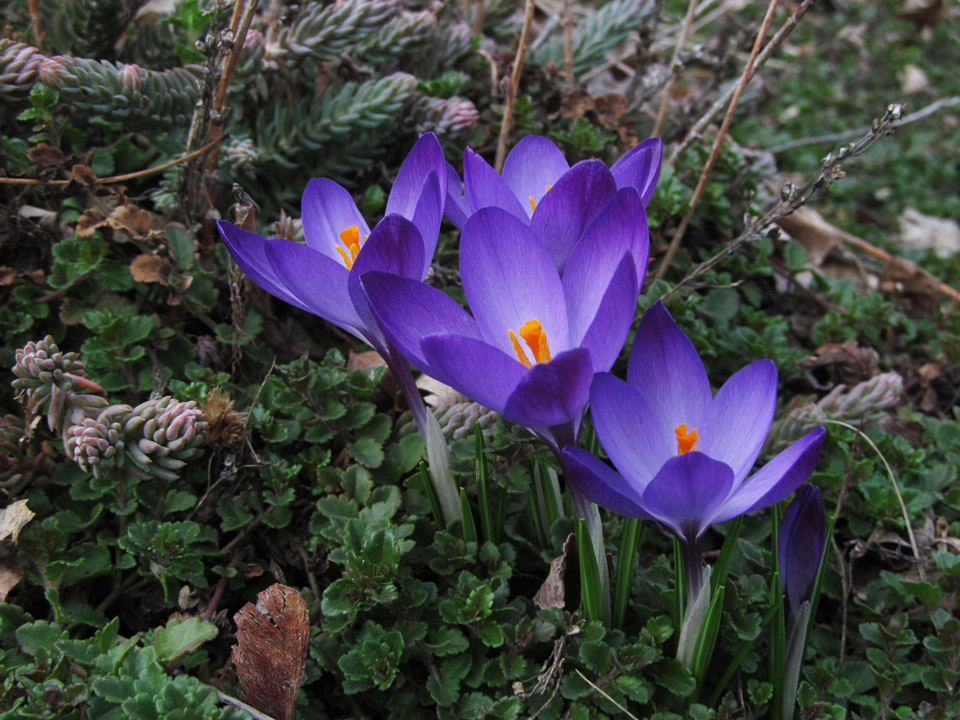
Crocus popping up through veronica and sedums.
The diversity of size, shape and color of spring blooming bulbs is fascinating. Some of the best bulbs to plant in our area are (listed in order of bloom time) :
Early Spring Bloomers: crocus, Siberian squill, snowdrops, dwarf iris, and species tulips
Mid-Spring Bloomers: hyacinths, daffodils, grape muscari, fritillaria and tulips
Late Spring Bloomers: alliums, irises and fox-tail lillies
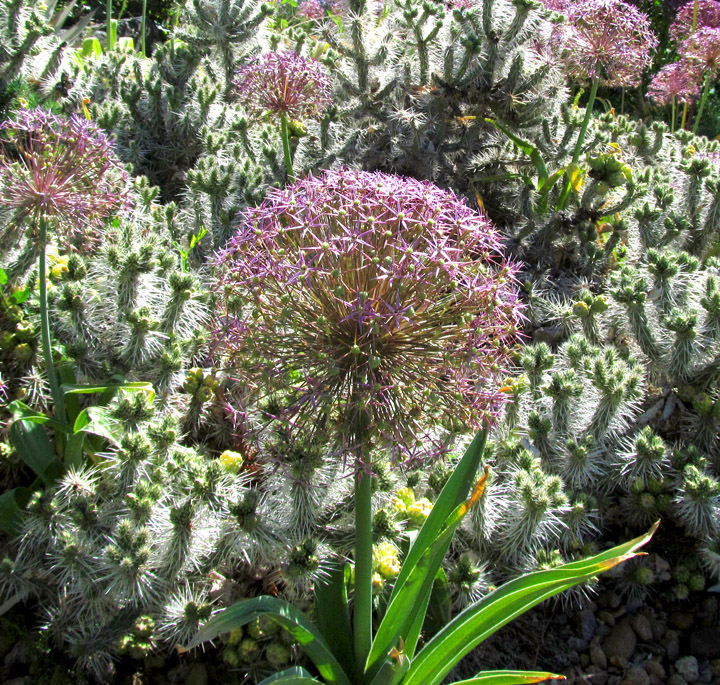
Alliums with Cholla cactus.
Fall planted bulbs do best in soils that are well drained. If the soil is too wet, the bulbs may rot. The rule of thumb is to plant the bulbs at a depth 3 to 4 times the length of the bulbs. If you buy bulbs in a package, a visual guide to bulb planting depth is usually printed on the package.
Consider adding “bulb food” to the holes you’ve dug before you drop in the bulbs. Phosphorus fertilizer will give your bulbs a boost, and help them become established. Traditionally a product called “bone meal” was recommended for providing phosphorus to bulbs. But research done at Colorado State University has shown that product doesn’t work well in our typically alkaline soil chemistry. Consider a conventional (a.k.a. “non-organic”) fertilizer called “triple super phosphate”. However, using phosphorus from conventional fertilizers has been linked to environmental damage such as toxic algae blooms in lakes and rivers. Use the conventional phosphorus sparingly and carefully. If you’ve not already done so, amending your soil with compost is also a good idea to improve soil texture for your bulbs.
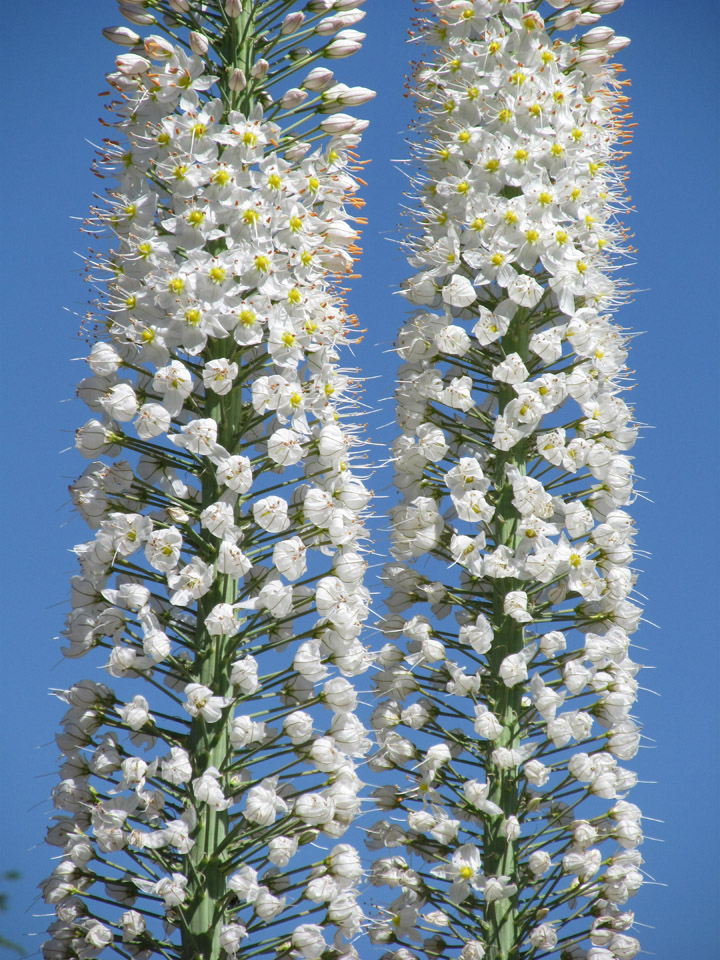
Close up of foxtail lillies.
Most spring blooming bulbs do best in full sun to part sun locations as opposed to deep shade. But if the site is south facing in full sun, that area’s soil may warm up too much in late winter, causing the bulbs to flower early and those blooms would be susceptible to frost damage during cold snaps. It is a good idea to mulch the soil where you’ve planted the bulbs. Mulch will keep the soil from drying out, and help moderate soil temperature so it doesn’t warm up too quickly.
Design-wise, you can tuck just a few bulbs into niches between established perennials and ornamental grasses in your garden, or you could add large groupings of one type of bulb to get maximum color punch in your landscape. One effective way to add bulbs to an existing garden is to place them around low-growing plants that will still be dormant when the spring bulbs emerge. That approach is particularly effective with low growing groundcover perennials. Some people will add early spring bulbs such as crocus or snowdrops to a lawn area, knowing that the grass won’t start growing or need a mowing until after the bulbs are done. And if you want to add bulbs year after year, you might want to make a plan or take photos of where the existing bulbs are when they are blooming. That way you can avoid disturbing the established bulbs next time you add more in the fall.
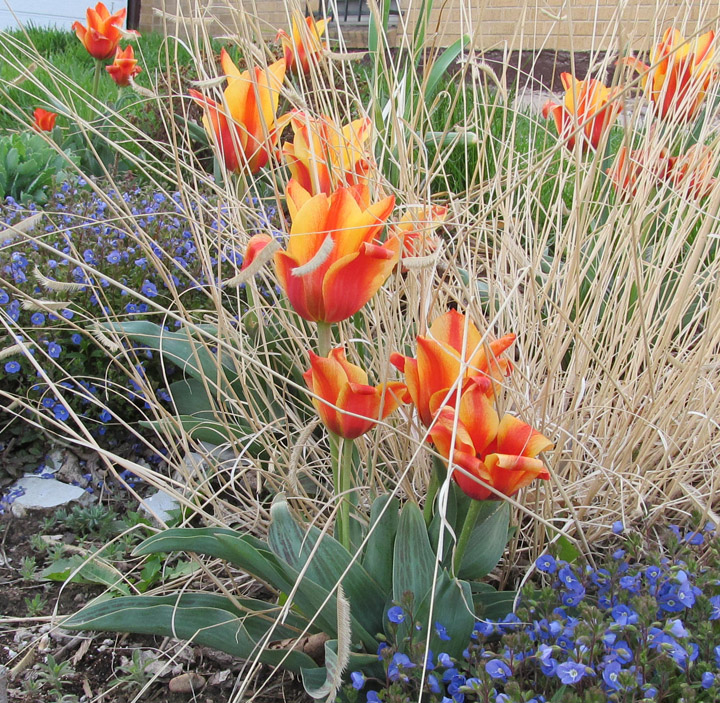
Tulips mingling with veronica and the remnants of last year’s ornamental grass.
For all the bulbs, you should not remove the leaves after the flowers have faded, until the leaves have turned from green to brown. Removing green leaves too early deprives the bulbs the ability to feed themselves in preparation for the next year’s blooms.
If your bulbs are “happy” where you’ve placed them, there’s a chance they will supply you with gorgeous blooms for many years. Adding spring blooming bulbs to your garden is an easy way to get dependable spots of color into your landscape for a springtime show!
This is the official blog of Outdoor Design Group, Colorado Landscape Architects. For more information about our business and our services, click here.
Related Posts:
by Todd Rutherford
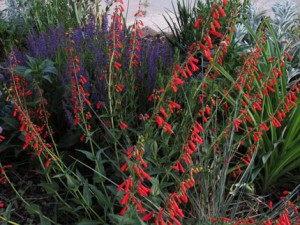
I took this photo of a Firecracker Penstemon (Penstemon eatonii) in my garden back in early June. We here in the Denver area were enjoying spring like weather at the time, and so the vivid red blooms of this beauty were still captivating the pedestrians in my neighborhood who passed it by. Despite its namesake, these blooms do not make it to July 4th, as this plant usually begins flowering in early to mid Spring. Behind the penstemon, you can see a blue salvia providing a lovely blue-purple counter note to the penstemon’s brilliant warm red. This particular plant is looking a little leggy. The bed where it resides gets a bit more moisture than the plant should be receiving. It is my understanding that many (if not most) of the penstemons do better on the drier side. For useful information on how best to care for penstemons, please see the list of penstemon growing tips on the High Country Gardens website. One characteristic I appreciate about Firecracker Penstemon is the foliage can be evergreen throughout our Denver winters. And, if you have hummingbirds visiting your yard, they might be happily feeding on the tubular flowers this gorgeous plant produces.
I started this plant indoors, from seed. Many of the penstemons are very easy to acquire this way. This ease of starting from seed obviously translates to the the plants reseeding themselves in the garden. However, I find they are only mild re-seeders, and not nuisance re-seeders like lamb’s ear or blanket flower.
I highly recommend you add a splash of red to your landscape with Firecracker Penstemon. If red is not the color you are after, there are several other penstemon species and hybrids to choose from that offer diverse flower colors on plants that are perfect for low-water landscapes.
This is the official blog of Outdoor Design Group, Colorado Landscape Architects. For more information about our business and our services, click here.
Related Posts:








